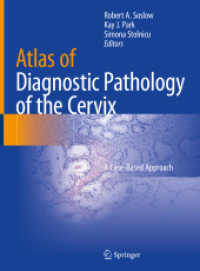- ホーム
- > 洋書
- > 英文書
- > History / World
Full Description
Early Medieval Britain was more Roman than we think. The Roman Empire left vast infrastructural resources on the island. These resources lay buried not only in dirt and soil, but also in texts, laws, chronicles, charters, even churches and landscapes. This book uncovers them and shows how they shaped Early Medieval Britain. Infrastructures, material and symbolic, can work in ways that are not immediately obvious and exert an influence long after their creators have gone. Infrastructure can also rest dormant and be reactivated with a changed function, role and appearance. This is not a simple story of continuity and discontinuity: It is a story of adaptation and transformation, of how the Roman infrastructural past was used and re-used, and also how it influenced the later societies of Britain.
Contents
List of Abbreviations
List of Maps
List of Figures
Acknowledgements
Prologue
Chapter I: Frameworks: From Historiography to the Principal Terms
1. Infrastructure
2. Governance Resource
3. Continuity
4. Re-Use
5. City
Chapter II: Movements: The Charters and Roman Transport Infrastructure
1. Writing Roads Down: Roman Roads in Documentary Practice
2. The Eastern Charters
2.1 Source Introduction
2.2 Roads and Bridges in Boundary Clauses
2.3 State of Maintenance
2.4 Obligations and Burdens
3. The Western Charters
3.1 Source Introduction
3.2 Roads in Western Charters
3.3 Alienation
4. Conclusions
Chapter III: Adaptations: Roman Urban Spaces in Post-Roman and Early Medieval Britain
1. A Very Long Goodbye: Recognising Roman Urbanism in Britain
2. Urban Spaces in the Sub-Roman Period (c. 382-c. 442)
2.1 Transformations of Roman Towns in Britain
2.2 409/410 - the Year(s) Nothing Happened?
2.3 Candidates for Limited Urban Survival
2.4 Coins and Urban Spaces
2.5 Problematising the Shift
3. Urban Spaces in the Pre-Conversion Period (c. 442-597)
3.1 Tax-Gathering and Re-Use of Roman Towns
3.2 Limited Town Functions the Idea of Multifocal Governance
4. Urban Spaces in the Conversion Period and the Times of Bede (597-735)
4.1 The Strategies of Activation
4.2 Sources of Authority
4.3 Between "Continuity of Place" and "Urban Continuity"
4.4 Perceiving Roman Urban Spaces
5. Conclusions
Chapter IV: Spaces: The Church and What Rome Left
1. Tinkering with the Past: Church and the Inheritance of Rome
2. Lawand Space
2.1 Regulating the Role of the Church
2.2 Acquiring and Granting Space
3. Symbolical Geographies
3.1 The "Christian Foundation Legend" and Roman Remains
3.2 Recreating Rome
3.3 Reoccupying Urban Spaces as Ecclesiastical Capitals
4. Memory and Infrastructure
4.1 Whithorn and Remembering Rome
4.2 Wilfrid and the Importing of Memory
5. Conclusions
Epilogue
Bibliography
Index







